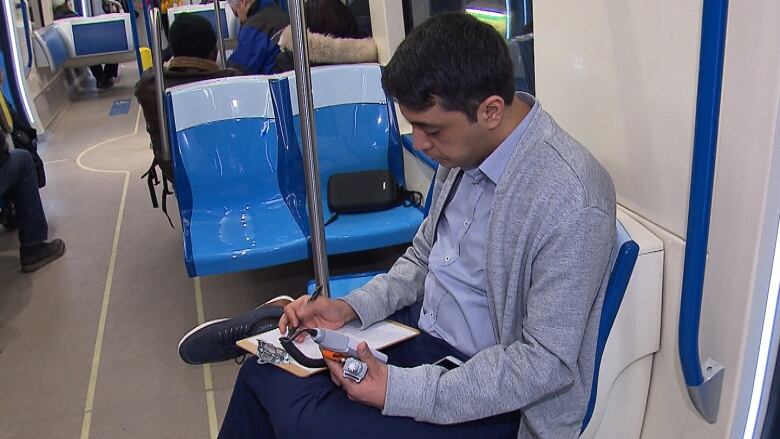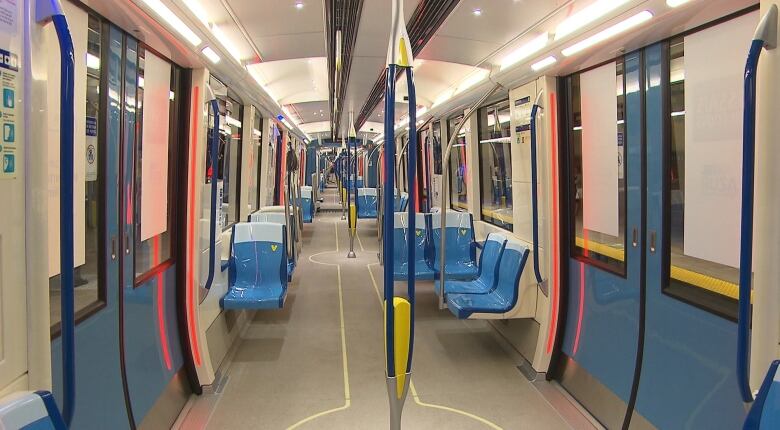Make the Metro more comfortable, and commuters will come, researcher says
Concordia researcher estimates he spent over 200 hours on the Metro taking measurements

The newer AZURtrains on Montreal's Metro are an improvement over older trains when it comes to rider comfort,but they could still be better,especially when it comes to sound levels, according to a Concordia researcher.
Alireza Mohammadiestimates he's ridden the Metro for over 200 hours, on the Orange, Blue and Green lines, in oldand new trains, in both the summer and winter, taking measurements for his work as aPhDcandidate in civil engineering.
His efforts wenttowardcreating what he describes as a comprehensive comfort assessment tool that can be used on public transit systems around the world.
Overall, he gives the newAzurtrains a "good" rating out of a five-category scale, with "excellent" being the best, and "very poor" being the worst. However, the new trains only get a "fair" ranking when it comes to sound levels.
He ranks the older trains on the Metro overall as fair.
He hopes to help transit systems improve rider comfort in order to lure more people out of their cars, as municipalities focus on becomingmore sustainable places to live and work.
- A longer Blue line, more Azur trains and improved accessibility part of STM's 2025 vision
- Travelling by public transit in Toronto exposes you to damaging bursts of sound, study says
His thesis supervisors suggested the topic, but he said his own frequent travels on the Green line in the older Metro cars made an impression on him.
"I was a daily traveller, so always I had a problem with thermal comfort during the winter, and also vibration and noise," he said.
Measuring, measuring
Mohammadi has been gathering data for about a year.
He rode the Metro lines end to end, starting in the morning and finishing in the afternoon, measuring severalfactors:
- Sound levels.
- Temperature.
- Humidity.
- Vibration.
- Lighting.
- Carbon dioxide.
Mohammadimeasured sound levels in terms of weighted decibels,which takes into account both noise level and exposure duration.
During a ride with CBC News, Mohammadi measured levels around 76.6 weighted decibelson a new AZUR train, and levels a bit over 80 weighted decibelson an older Metro car.
Mohammadi gives a ride of around 80 decibels a fair rating, not good or excellent. He noted that users who are listening to headphonesmight be tempted to turn the volume up, which could be fatiguing and uncomfortable.

According to his observations,noise levels within the Metro are withinsafe levels for human hearing. Federal safe work place guidelines statethe maximum safe amount of time to be exposed to a noise around 87 decibels is eighthours.
Other factors that he took into account include vibration, which he measured by recording acceleration with a smartphone.
He thenused that acceleration data tocome up with a weighted average he used to determine overall rider comfort.
"Vibration is very important when you're sitting and trying to read or concentrate," he said, adding that of course lighting is another factor to riding comfort.
Overall, he says Montreal's Metro is quite warm, and he pointed out it may feel more uncomfortable in the winter because people are dressed for subfreezing exterior temperatures, not the balmy 24-26 C found inside Metro trains.
But he cautions that it is difficult to focus on one factor at the expense of others.
"Generally, we cannot actually assign priority to comfort factors. Because some people are sensitive to noise, some to...vibration," he said.
He did an online survey of over 200 Metro riders at Concordia and found a slight preference for temperature as the most important comfort factor,followed by noise, but cautioned the differences were not significant.
Newer is better

The STM says ittook comfort into accountas the service went through the five-year process of obtaining the new trains.
From 2007 to 2012, the transit agencyheld focus groupsand conducted surveys on the design of the interior of the cars, and communications system.
The newerAZUR cars have plenty of features meantto make riders happy, including:
- An environment that minimizes noise.
- Scratch and graffiti resistant surfaces.
- Indirect, softer lighting.
- Better suspension to minimize vibration.
- Ergonomic seating.
- Wider doors.
However, some riders complained to the STMwhen the cars were first launched, complaining that grab bars weren't placed to be easily accessible to shorter people, that the ventilation was too was too strong and "pushes the air directly in the face of users facing forward" and that the new cars were too hot.













_(720p).jpg)


 OFFICIAL HD MUSIC VIDEO.jpg)
.jpg)



























































































